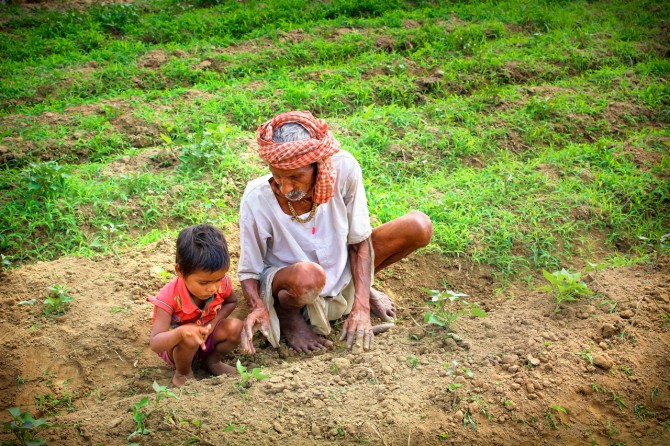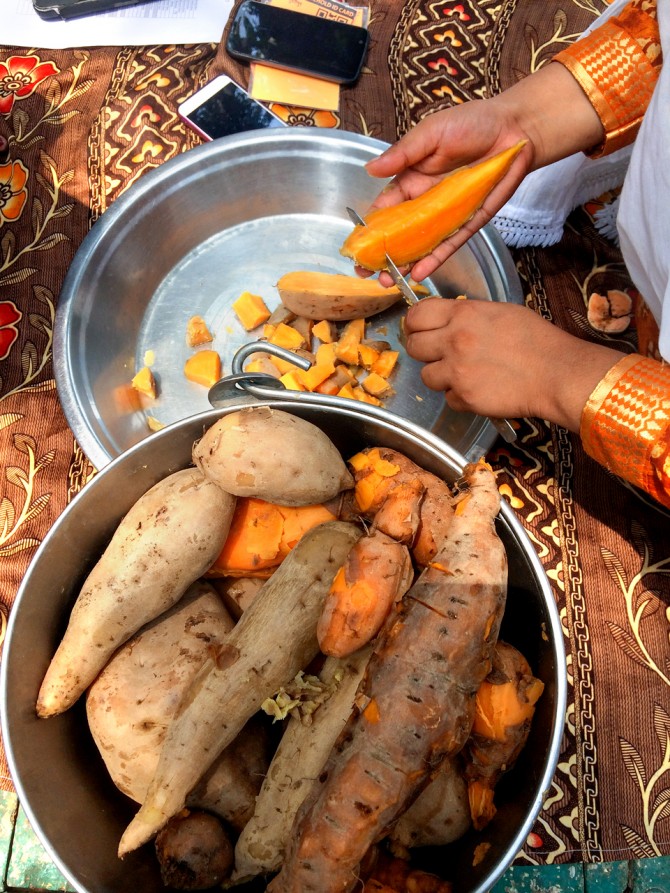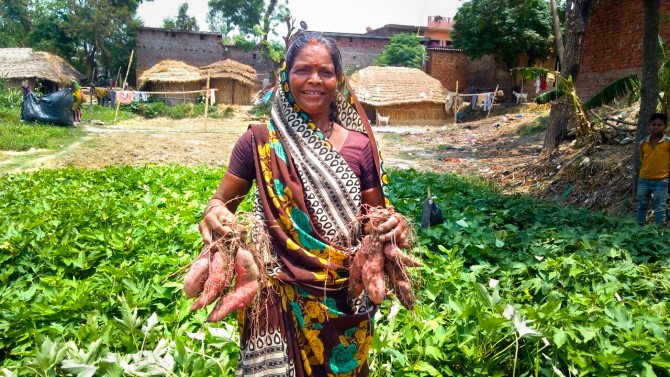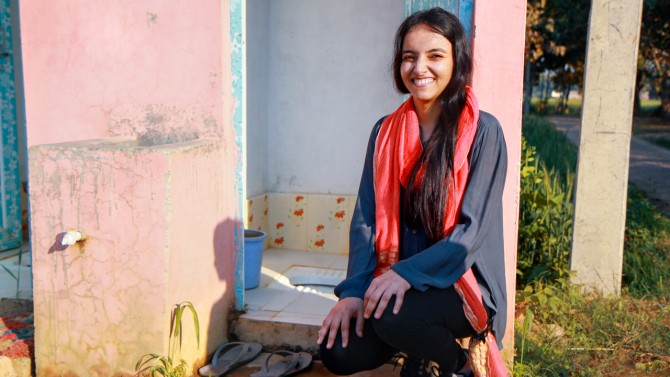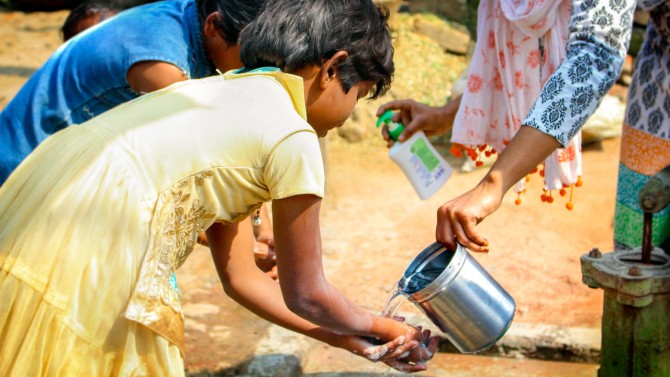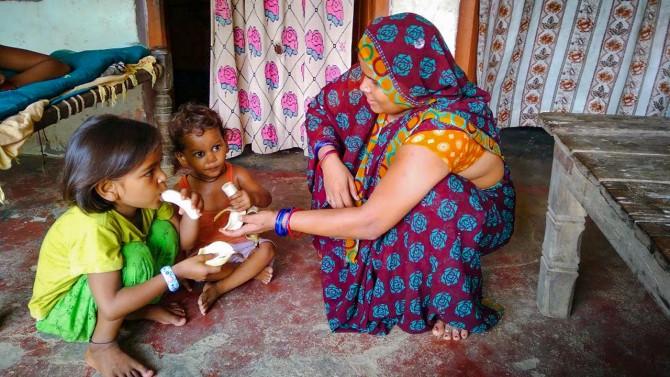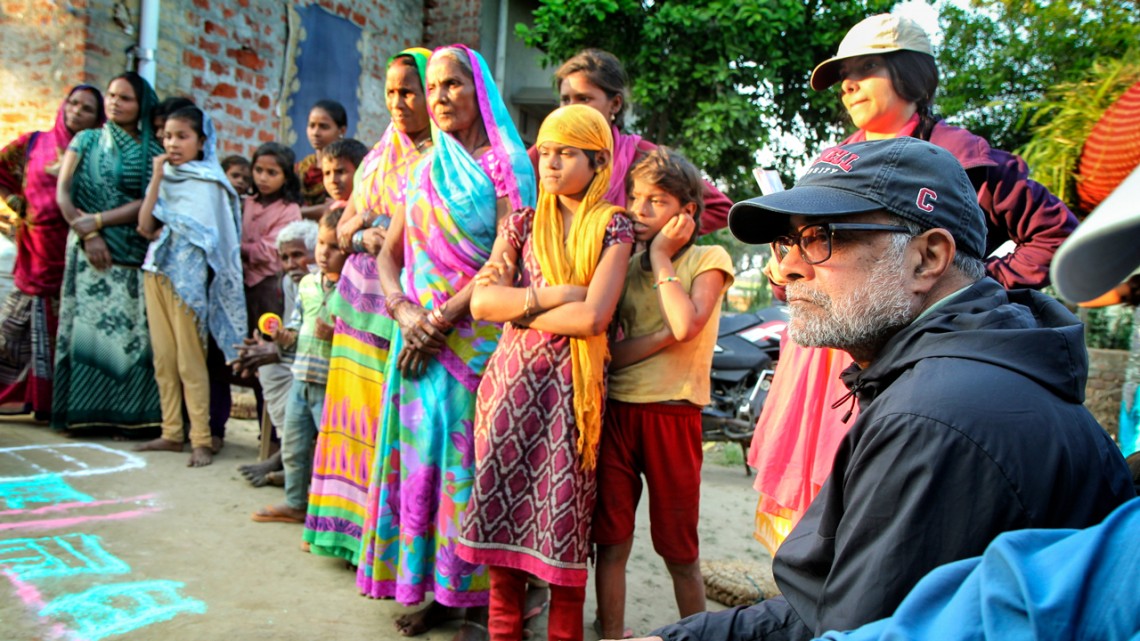
Prabhu Pingali (with baseball cap), founding director of the Tata-Cornell Institute for Agriculture and Nutrition, observes a community discussion in Rangpur, Uttar Pradesh, India.
For Prabhu Pingali, India’s malnutrition puzzle is personal
By Jonathan Miller
It has been a long journey for Prabhu Pingali. After more than 40 years studying agriculture and food systems across the developing world, the faculty director of the Tata-Cornell Institute for Agriculture and Nutrition is now focusing full time on his native India, trying to answer a riddle that has stumped a generation of scholars and policymakers.
“This is like coming home for me,” he says.
Pingali, 64, grew up in a farming village in Andhra Pradesh, in southern India. His father was a country doctor who built a free clinic for the area’s poor families. He was 12 years old when the first modern, high-yielding varieties of rice arrived – the vanguard of what would become the Green Revolution.
“Yields went from one crop per year at 1 ton per hectare to two crops with an average yield of 4 to 5 tons,” he remembers. Suddenly farmers had more money. More children went to school. And the standard of living for most of his neighbors improved dramatically. “It was a transformative change in a very short period of time,” he says. “So agriculture and food were sort of chiseled into my brain from that point on.”
Pingali went on to get a Ph.D. in agricultural economics from North Carolina State University. He worked in the Philippines, Italy and Mexico, at institutions including the World Bank, the United Nations and the Bill & Melinda Gates Foundation. In 2013, he moved to Cornell, where he directs the Tata-Cornell Institute (TCI) and teaches applied economics at the Charles H. Dyson School of Applied Economics and Management.
Lately, he has turned his attention to the relationship between agriculture and nutrition, a connection that may seem obvious but that is poorly understood.
His latest book, “Transforming Food Systems for a Rising India” – co-authored by Anaka Aiyar, Mathew Abraham and Andaleeb Rahman – tackles what is often called “the Indian enigma.” Despite the country’s economic boom and impressive improvements in food production, income, literacy rates and many other measures, roughly 15% of all Indians– nearly 200 million people – remain malnourished. That rate is worse than in many of the poorest countries in sub-Saharan Africa.
“India has made huge progress on hunger reduction, especially calorie consumption and energy requirements,” Pingali observes. “But in terms of nutritional outcomes, we’ve lagged behind.”
Meanwhile, the country’s agricultural policies, rooted in a fear of famine, continue to promote the “big three” staple grains: rice, wheat and maize. Yet the solution to malnutrition, Pingali asserts, is not more grain, or even necessarily more food. It is better food, better diets, better markets, better education and better sanitation. To achieve all those, the country needs better policies. And to guide the policies, it needs better data. He has designed the TCI program to prove that point.
Pathways to improve nutrition
Pingali and his TCI colleagues have identified four intertwined pathways to improve nutrition.
First is increased income. When household incomes go up, families have more cash to invest in food production or to spend on healthy food at the market. Not that they always do – for a variety of reasons, many opt for high-energy, low-quality processed foods and sugary drinks. This has led to a sharp rise in obesity, even in families where some members are malnourished.
Second is dietary diversity. Low-income Indians tend to eat the same few things day in and day out, mostly staple grains. In rural areas, where people rely largely on food they produce themselves, diversifying means growing different crops, raising livestock or cultivating kitchen gardens. All this requires labor, knowledge, money and access to seeds and other inputs.
Third is what Pingali calls “positive nutrition behavior.” In traditional Indian households, men eat before children, boys eat before girls, older children eat before younger children and women eat last. Children and pregnant or lactating women often get less than they need.
Fourth is improved sanitation. Despite decades of toilet construction campaigns, 40% of Indians are still believed to defecate outdoors. Few wash their hands after doing it. And while most villages now have communal pumps or piped water, that water is often contaminated. Diarrhea is stubbornly common, especially among children. Even if they eat enough food, they can’t absorb the nutrients.
Pingali acknowledges that this simplified framework is hardly simple. “We’re talking about a problem that is multisectoral and multidimensional,” he says. “Unfortunately, people take a very siloed approach.”
On-site science
Pingali sits with a few dozen villagers in a clearing by a water pump in Karihaniya, not far from the Nepal border. He wears a Cornell baseball cap, maroon T-shirt and black jeans. The village men, in drab shirts and baggy trousers, sit on one side; the women, in colorful saris, sit on the other.
The villagers are describing their experiences with orange-fleshed sweet potatoes. The tuberous roots are high in vitamin A, a crucial nutrient, but they are new to the area. Pingali asks questions but mainly he listens.
“We love the taste,” a woman reports. “Especially the children.”
“There’s no market for it,” a man counters, “so we’re only growing a little for ourselves.”
The sweet potato initiative is half development project, half science experiment. What does it take to get farmers to grow new crops that provide essential nutrients? What does it take to get consumers to eat them?
A local NGO, Grameen Development Services (GDS), works with the communities while a Cornell nutrition Ph.D. student, Kathryn Merckel, MPS ’15, documents the process, collects data and analyzes results.
The partnership with GDS is part of a much larger endeavor, called Technical Assistance and Research for Indian Nutrition and Agriculture (TARINA). Organized by TCI in 2015, TARINA is a consortium of Indian, U.S. and international nonprofits, foundations and universities with funding from the Gates Foundation. TARINA has projects in more than 160 villages in Uttar Pradesh, Bihar and Odisha states. Each project team includes a graduate student or postdoctoral fellow who spends significant time on-site.
The scholarly component is an essential part of the model. “Development organizations often use anecdotal evidence to demonstrate impact,” Pingali says. “We’re trying to do things in a very different way.” The Ph.D. students work with their advisors to design experiments that that can stand up to rigorous scrutiny by fellow scientists. “And so we have very clear and accurate information about the change that’s happening,” Pingali says.
After the sweet potato discussion, Pingali walks with farmers and NGO workers along the narrow embankments between outlying fields. They inspect a crop of wheat that has been bred to contain high levels of zinc, another nutrient that local diets often lack. The wheat looks green and healthy.
But Pingali isn’t pleased. The team has not taken sufficient care to separate the zinc-fortified seeds from the nonfortified ones. As the setting sun turns a spectacular red, he patiently explains how to conduct the experiment more meticulously next time.
Changing nutrition behaviors
The TARINA portfolio is designed in large part to test the theory of nutrition pathways that Pingali and his colleagues have developed, as well as to tease out the relationships among them. The findings will eventually coalesce into policy recommendations.
It may be that macro factors such as governance, infrastructure and market realities have the greatest impact. But individual attitudes also play a role. Several TARINA projects include “behavior change communication,” to encourage people to modify their eating habits or improve their sanitation practices.
Pingali accompanies Cornell applied economics Ph.D. student Payal Seth to Kaharpurwa, a village of 44 households that she has been studying for nearly a year. Her research attempts to determine why people who have access to toilets tend not to use them, and whether a behavior change campaign might make a difference.
The village is a warren of uneven footpaths and modest block houses. A year earlier, all but one household (which had no space to spare) received a brick outhouse with a built-in washbasin, running water, tile floor and ceramic pit toilet. Residents were required to pitch in with labor or cash valued at 25% of the toilet’s cost. They also had to go through an initial training.
In one GDS training exercise, which is well-known in India, villagers accompany a trainer to an area where people defecate. The trainer dips a human hair into a pile of fresh feces, then into a glass of water, and offers the water to the villagers, who vehemently refuse to drink it. Meanwhile, flies flit back and forth between the feces and a nearby plate of rice. On its six feet, the trainer points out, each fly carries more excrement than the strand of hair. The demonstration makes an impression.
As Pingali and Seth walk through the village, women pop out of their houses to show off their toilets. (Seth, a native of New Delhi who had never spent much time in rural areas, is now known here as “Toilet Girl.”) The outhouses are brightly painted and their interiors are clean. Their children haven’t been sick since the toilets went in, the women marvel. Indeed, Seth says, all the toilets in Kaharpurwa are still in use a year after the behavior change campaign.
In other villages, where toilets were installed but there was no behavior change exercise, usage is significantly lower. This seems to suggest that behavior change communication is a critical factor in ensuring adoption. If true, this could have huge implications nationwide.
Pingali grills Seth on her data: How much does she know about the villagers? Has she done a census? How does she really know whether a toilet is being used or not? More importantly, can she prove it?
The point is not that the data are bad – in fact, just the opposite. “When you have an impact like this, when every household [is using] the toilet that they built through this program, then people [will] say that’s too good to be true,” Pingali says. “That’s why we actually spend a lot of time checking the data, doing on-the-spot checks, making sure that everything we have is correct, so we can stand by these results.”
Later that day, Pingali watches Shweta M. Joshi, GDS’s behavior change specialist, conduct the first of 14 multihour sessions in the village of Rangpur. Joshi will cover not only toilet use but also eating habits, farming practices and a host of other issues. The session begins with a raucous exercise in which residents draw a giant map of their community in powdered chalk on the hard-packed ground.
About 75 people are there, laughing and yelling as their neighbors sprinkle color-coded chalk denoting paths, gardens, wells, ponds and places of worship. Whenever the noise gets out of hand, Joshi shouts, “Namaste! Namaste! Namaste!” (“Hello! Hello! Hello!”) and the group briefly quiets. When she asks them to identify their biggest concerns, they vociferously complain about high prices and the lack of jobs.
Pingali watches but doesn’t speak. “This is a good way to bring the village together to think about their problems,” he says after the session wraps up. “It gives them much more ownership compared to the usual way of doing things: flying in and saying, ‘Here’s your problem, and we’re going to solve it for you.’”
The hunt for reliable data
Spend time in almost any Indian village, and you can see many things that could use improvement, from diets and water systems to wages and security. With more than 2 million NGOs in the country, there is no shortage of people working on these issues.
Pingali wants to show which interventions are effective, where, in what combinations and at what scale. For that, he needs reliable data.
“What I really want to do,” he says, “is look at each district within India and say, ‘What has been the development experience of that particular district over the last 75 years?’ and then match that against the child-stunting, child-wasting parameters for that district.
“If I look at household data over time, and then track the same households and see what has happened to their incomes and what has happened to their nutrition outcomes,” he says, “then I suspect I would see a very different story than if I look at India as a whole … . But we don’t have that [data].”
India collects enormous amounts of information, Pingali says, but not always in the most useful ways. Sometimes it is out of date; other times it is not made public.
“Open, transparent data is really absolutely crucial for us to make research decisions, policy decisions, investment decisions,” he says.
In the meantime, Pingali has his opinions. If he could get the Indian agriculture ministry to do just one thing, what would it be? He says it should abandon its “staple grain fundamentalism” and adopt “nutrition-sensitive” policies – that is, agriculture that explicitly aims to improve the quality and diversity of diets.
And if he could choose just one of the four nutrition pathways, where would he invest? He mulls the question for a moment.
“If I worked on two – on income growth at the household level, moving people out of poverty, and if I worked on women’s literacy – I could pretty much drive all the other ones,” he says.
It’s not an entirely scientific assessment but one that is built on four decades of observation and study. Soon, he hopes, he’ll have the data to prove it.
Freelance journalist Jonathan Miller has reported from more than 20 countries for magazines, radio and television.
Media Contact
Get Cornell news delivered right to your inbox.
Subscribe